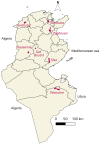Assessment of the Knowledge, Attitude, and Perception (KAP) of Sheep Farmers Regarding Ticks and Tick-Borne Pathogens in Tunisia, North Africa
- PMID: 39852877
- PMCID: PMC11769336
- DOI: 10.3390/vetsci12010002
Assessment of the Knowledge, Attitude, and Perception (KAP) of Sheep Farmers Regarding Ticks and Tick-Borne Pathogens in Tunisia, North Africa
Abstract
Ticks and tick-borne pathogens (TBPs) are a threat to human and animal health worldwide. A structured questionnaire was used to assess the knowledge, attitudes/practices, and perceptions (KAP) of 86 farmers of extensive sheep farming systems across different agro-ecological areas in Tunisia. The response rate was about 91.3%. Overall, 68.5% of the questions referring to knowledge and perceptions were answered correctly. Indeed, about half of the respondents were aware that ticks infest animals, with weight loss given as the major consequence. However, more than half of the farmers were unaware of the transmission and vectorial role of ticks. Those who knew that ticks are vectors cited microbes and icterus as the main concerns. A broad majority of farmers (70.9%) stated that they removed the attached ticks manually and 45.3% crushed them. As acaricides were perceived to be efficient for fighting ticks, according to 97.7% of the sheep farmers, they were used for both the animals and their sleeping areas. Although the toxicity of acaricides is known, 59.3% of the respondents did not use personal protection equipment when applying these products. Taken together, gaps in KAP among sheep farmers were identified. It can be used to better design awareness communication tools for TBPs.
Keywords: North Africa; ectoparasites; questionnaire.
Conflict of interest statement
The authors declare no conflicts of interest.
Figures





Similar articles
-
A knowledge, attitudes, and practices study on ticks and tick-borne diseases in cattle among farmers in a selected area of eastern Bhutan.PLoS One. 2021 Feb 22;16(2):e0247302. doi: 10.1371/journal.pone.0247302. eCollection 2021. PLoS One. 2021. PMID: 33617588 Free PMC article.
-
Assessment of farmers' knowledge, attitudes and control practices (KAP) to mitigate acaricide resistance and tick-borne diseases.Parasitology. 2024 Aug;151(9):971-982. doi: 10.1017/S0031182024001331. Epub 2024 Oct 25. Parasitology. 2024. PMID: 39450751 Free PMC article.
-
Communal cattle farmer's knowledge, attitudes and practices on ticks (Acari: Ixodidae), tick control and acaricide resistance.Trop Anim Health Prod. 2020 Nov;52(6):3005-3013. doi: 10.1007/s11250-020-02319-1. Epub 2020 Jun 14. Trop Anim Health Prod. 2020. PMID: 32535803
-
Hard ticks (Acari: Ixodidae) and tick-borne diseases of sheep and goats in Africa: A review.Ticks Tick Borne Dis. 2023 Nov;14(6):102232. doi: 10.1016/j.ttbdis.2023.102232. Epub 2023 Jul 31. Ticks Tick Borne Dis. 2023. PMID: 37531888 Review.
-
A systematic review of ticks and tick-borne pathogens of cattle reared by smallholder farmers in South Africa.Curr Res Parasitol Vector Borne Dis. 2024 Jul 27;6:100205. doi: 10.1016/j.crpvbd.2024.100205. eCollection 2024. Curr Res Parasitol Vector Borne Dis. 2024. PMID: 39258000 Free PMC article. Review.
References
Grants and funding
LinkOut - more resources
Full Text Sources
Research Materials

